I recently took a trip to Sigüenza, which may not ring a bell for many travelers, but it should! The town isn’t usually included in tourist brochures; it’s one of Spain’s best-kept secrets! Its quiet streets and friendly atmosphere create the perfect setting for a getaway. If you’re a fan of medieval architecture and history, you should definitely check it out next time you’re in central Spain.
Getting to Sigüenza is very straightforward—which is great because Madrid is my home base! A comfy regional train ride took me straight into the heart of this underrated treasure in just under two hours. If you’re in Madrid and looking for a day trip or a quiet weekend getaway, Sigüenza should be on your list.
Personal tip: Remember to check the train schedules as some Regionales skip town on their way to Soria or Zaragoza.
In this article, we’ll explore the best things to see in Sigüenza and discover practical information, such as how to get there and some of the best places to stay during your visit to this Spanish gem.
Visiting Sigüenza: An Overview of the Town
Sigüenza is located north of Guadalajara, in the Autonomous Community of Castilla-La Mancha, Spain. Its location on a valley a thousand meters (3,200 ft) high made Sigüenza a coveted spot during its long history, as it made it easy to defend from enemy attacks.
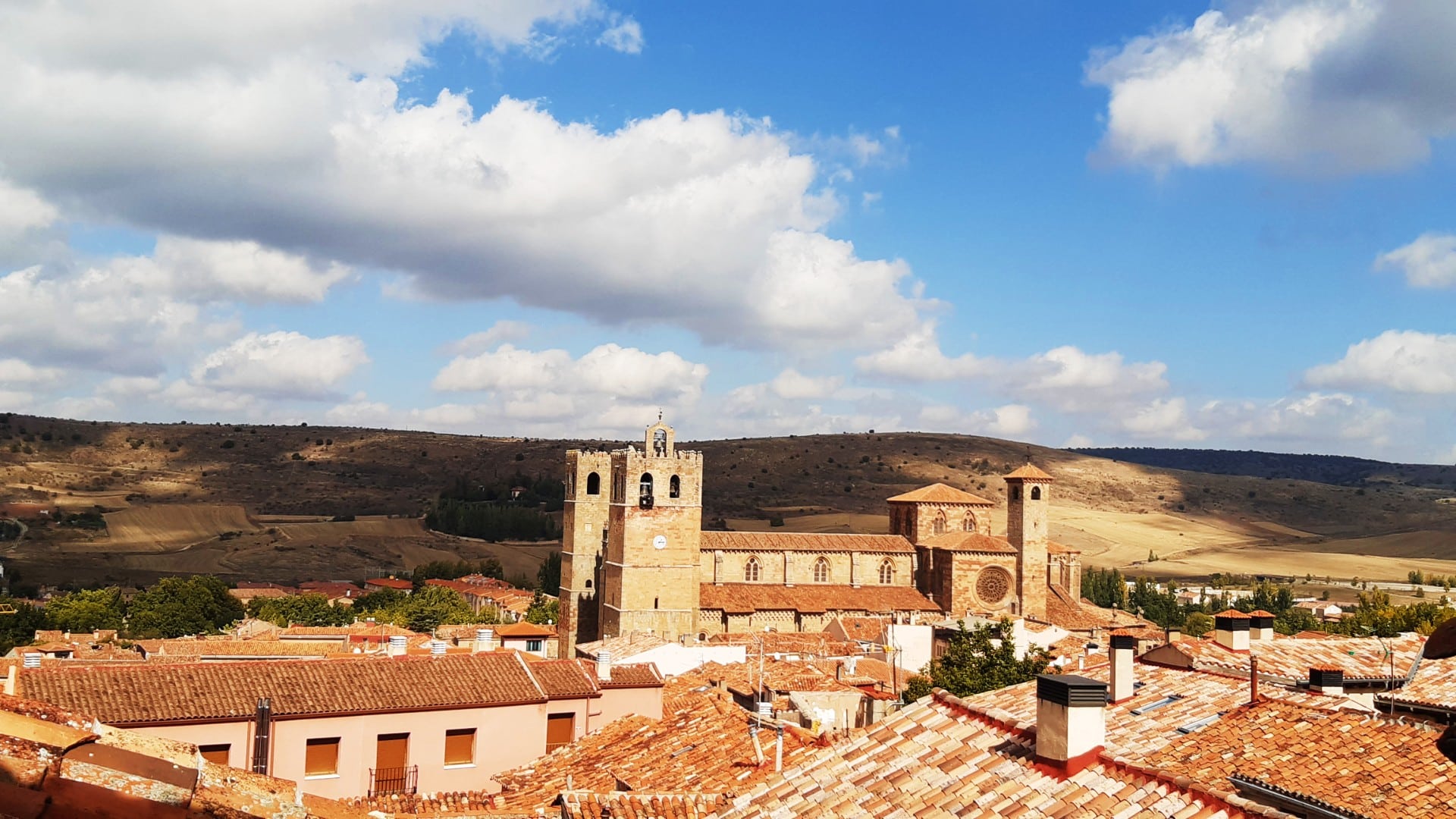
Sigüenza may be a small town, but it has a big past. It has been around since the Bronze Age. It was an important spot for Romans and Moors. Today, if you walk through the town’s old streets, you’ll walk along paths worn down by thousands of years of history.
Fun fact: The name Sigüenza (see-wen-tha) originated from the ancient Roman city of Segontia. Segontia itself might derive from a pre-Roman or Celtic root believed to be connected to the word “sego,” meaning ‘victory,’ or ‘strength. Over time, as languages with the influence of Visigothic and Arabic, the name transformed into “Sigüenza.”
The city’s history dates back to pre-Roman times when the Celtiberians founded the settlement. In the 8th century, Moors occupied the area and built an impressive castle that still stands today as a luxury hotel.
In 1123, Alfonso VII conquered Sigüenza and made it a Christian city. During this time, many of its notable buildings were constructed. For example, in the 12th and 13th centuries, the beautiful Sigüenza Cathedral was built in the Gothic style. Bishop Don Bernardo de Agen was essential in promoting this project.
Throughout history, Sigüenza has seen several influential people pass through. The famous Spanish writer and philosopher Miguel de Cervantes visited and wrote about Sigüenza in one of his books. Another notable figure is Pedro Gonzalez de Mendoza, who became an essential figure in Spanish politics during the 15th century.
In the 19th century, the French invasion led by Napoleon caused substantial damage to many historic buildings. This event greatly affected Sigüenza’s development for years to come. However, after rebuilding and growth during the latter half of the 20th century, Sigüenza has become an attractive destination for travelers interested in history.
Personal take: While Sigüenza is a somewhat famous day-trip destination for Spaniards, particularly from Madrid, it is widely (and unfairly) overlooked by most international visitors. During my visit, I didn’t notice many foreign tourists wandering about.
Top Things to See in Sigüenza, Spain
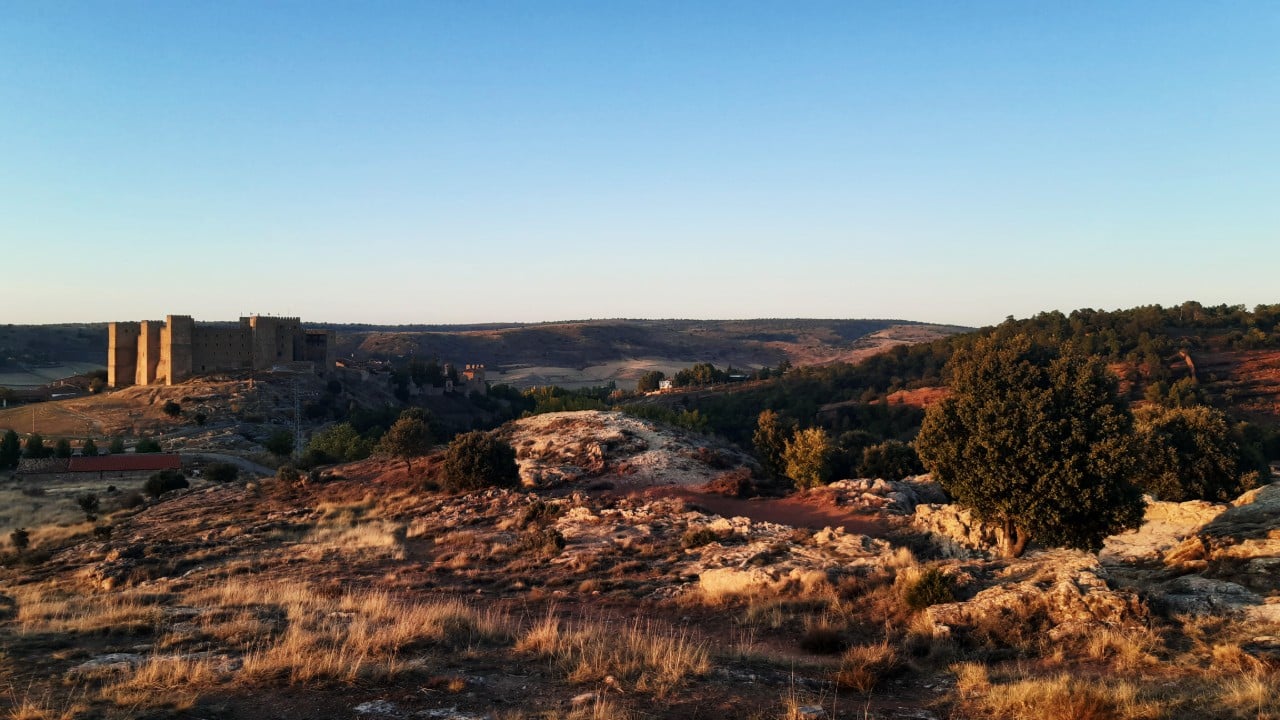
Although it is not nearly one of the most visited places in Spain, Sigüenza’s great historical heritage, food, and landscapes make it the ideal destination for a weekend getaway. Here are some of the things you can’t miss in Sigüenza:
1. Sigüenza Castle
The castle of Sigüenza is located at the city’s highest point and currently serves as a historic hotel and restaurant.
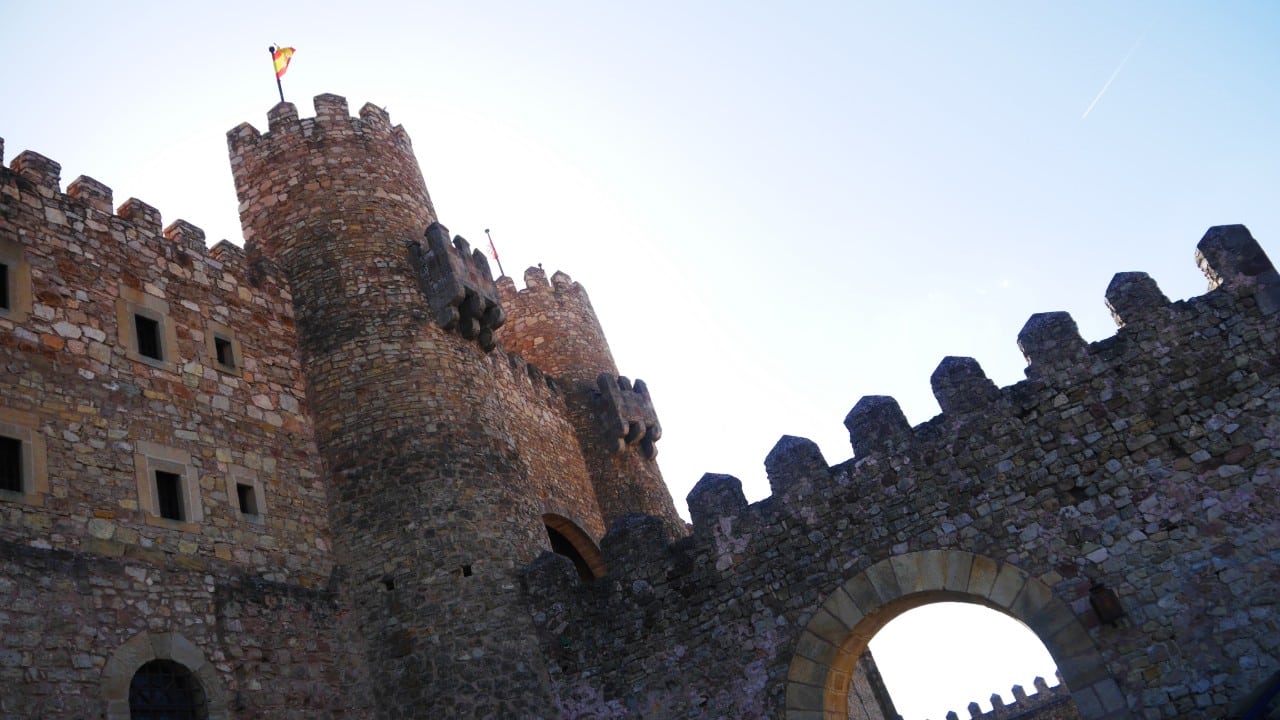
This twelfth-century fortress will make you feel like you’re in an episode of Game of Thrones with its imposing walls and beautiful parade ground featuring a fountain, a garden, and an ancient well.
Sigüenza Castle has a long and fascinating story. It started in the 5th century as an Arab fort. Over time, it changed hands between the Moors and Christians during the Middle Ages, and it was later abandoned for a while. In the 12th century, Bishop Don Bernardo de Agén rebuilt it, hence its name, “Castle of the Bishops.”
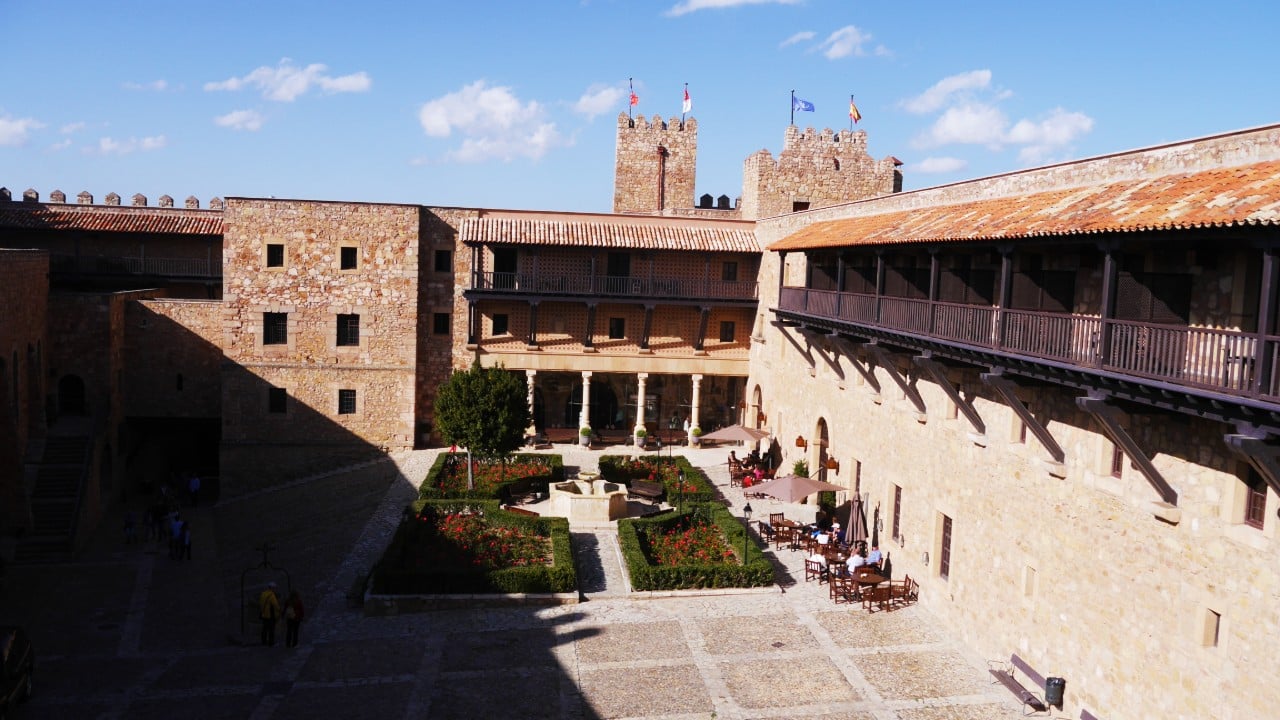
Fun fact: Sigüenza Castle is famously believed to be haunted. The most famous otherworldly resident of the castle is said to be the “Lady in White,” believed to be Doña Blanca de Borbón, who was imprisoned and died within the castle walls in the 14th century. Her apparition is often reported to wander the castle corridors, especially near her original cell. Another ghostly presence is a Spanish Civil War soldier, who some say can still be heard through the echoes of his footsteps in now-silent halls.
I had the pleasure of staying at the Parador during my visit, and while I didn’t see any ghosts, the experience was magical. That said, you don’t need to stay there in order to visit the castle, you can enjoy free access to the courtyard and the restaurant. This is, without a doubt, one of the must-see attractions in Sigüenza.
Personal tip: Climbing “Colina del Polvorín” at sunset gives you the best views of the castle.
2. Cathedral of Sigüenza and the Chapel of the Doncel
The Catedral de Santa María de Sigüenza is a beautiful example of Romanesque architecture. Built in the early 12th century, around 1124, it has been an important landmark throughout history. Bishop Bernardo de Agén ordered its construction after the Christian conquest of the city from the Moors. Over time, the cathedral also saw additions in Gothic and Renaissance.
Holes caused by shrapnel from bombings and clashes during the Spanish Civil War can still be seen on its façade.
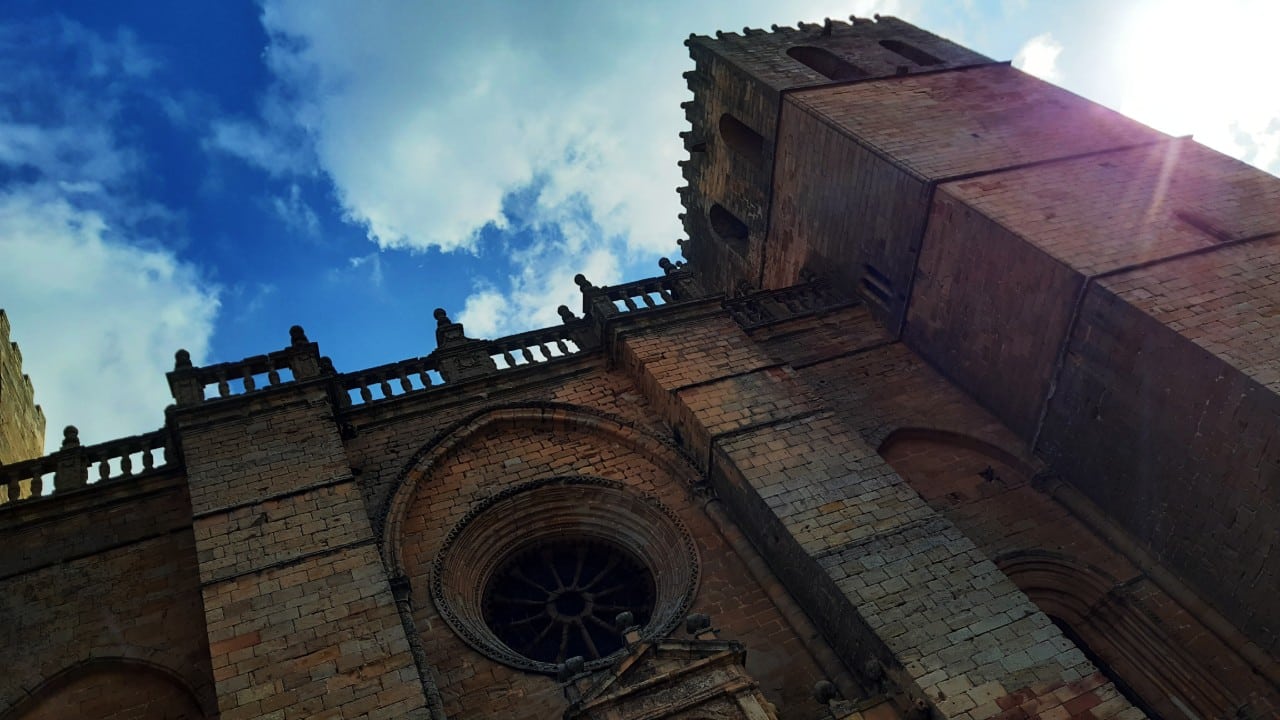
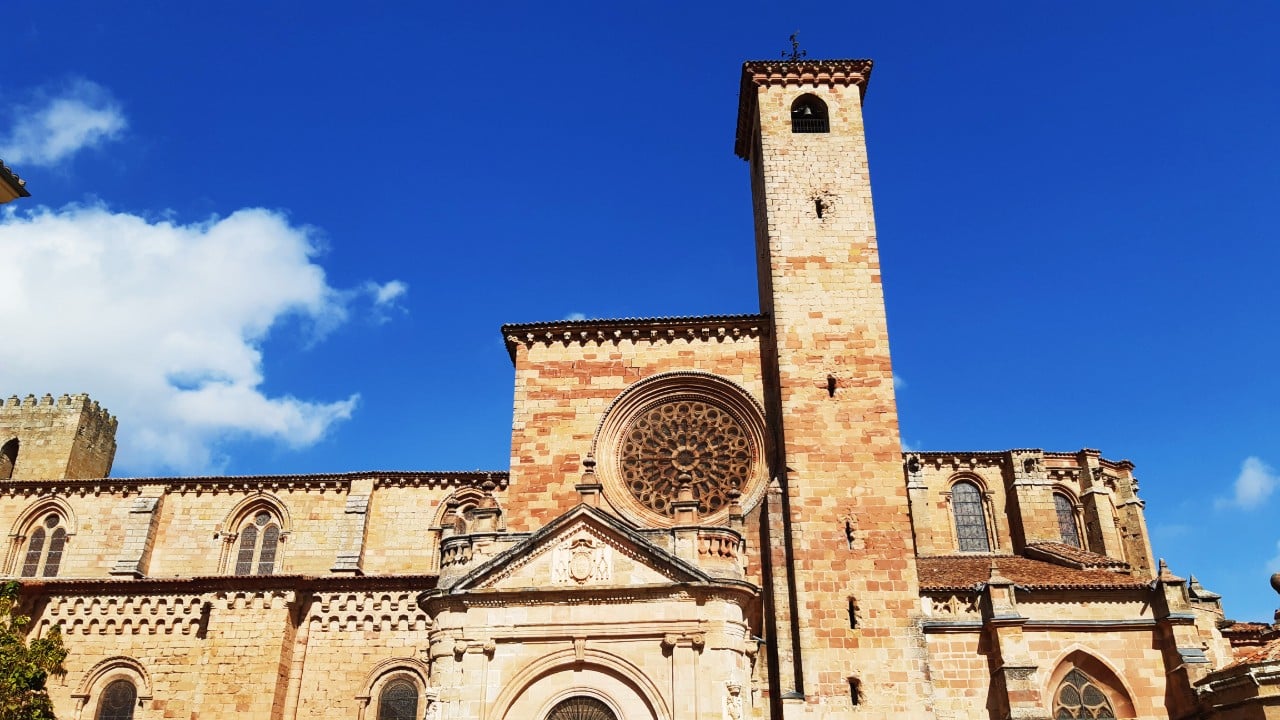
The interior of the Cathedral is notable for its sturdy columns and semi-circular arches, typical of Romanesque design. The layout follows a Latin cross plan with a transept and three naves.
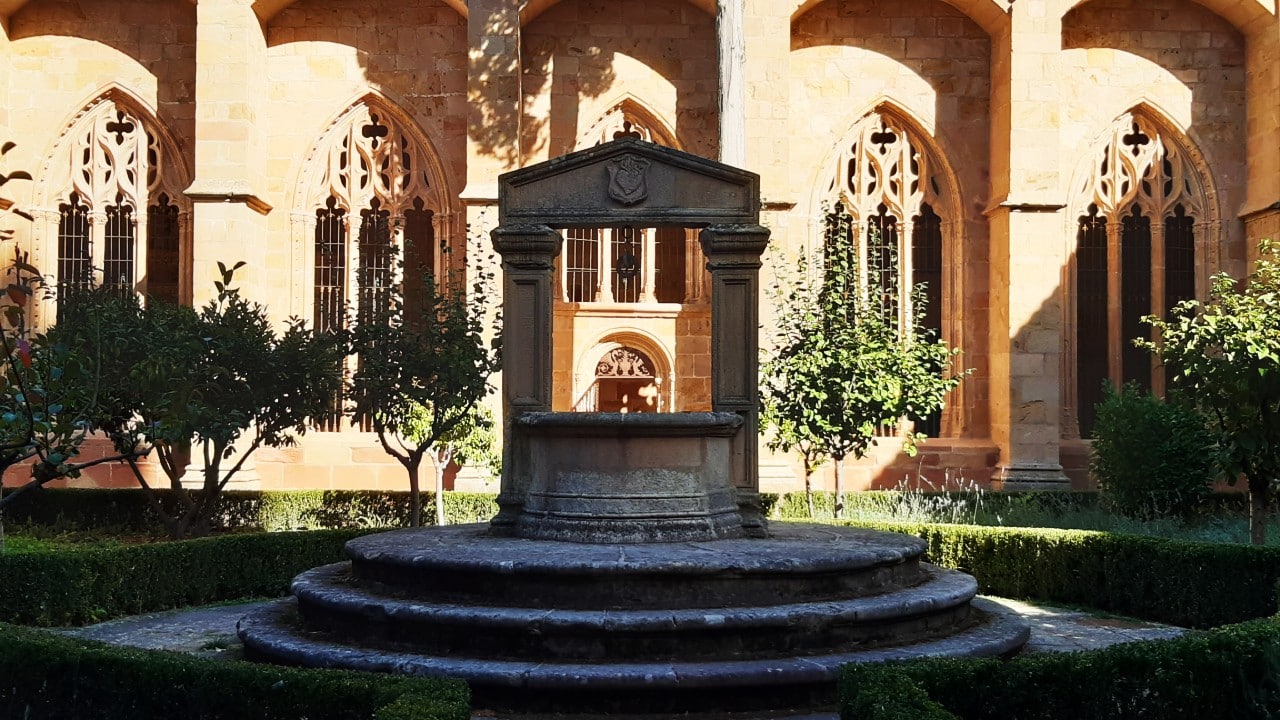
One remarkable feature inside is the elaborate sepulcher of Martín Vázquez de Arce, also known as ‘El Doncel de Sigüenza,’ a young nobleman who died in battle during the late 15th century.
Fun fact: The groundbreaking thing about “El Doncel” is that he’s dressed as a soldier but lying down and reading a book, a revolutionary position for the time since sepulchral art in the Middle Ages traditionally showed the deceased sleeping.
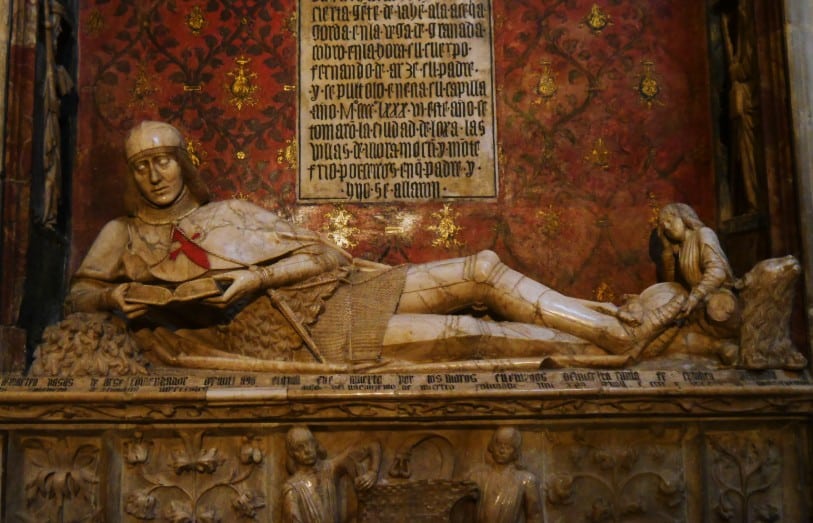
In this chapel, you’ll also see the tombs of El Doncel’s parents and uncle, which are adorned by sculptures with a more traditional depiction. This further highlights the peculiarity of the young man’s sepulcher.
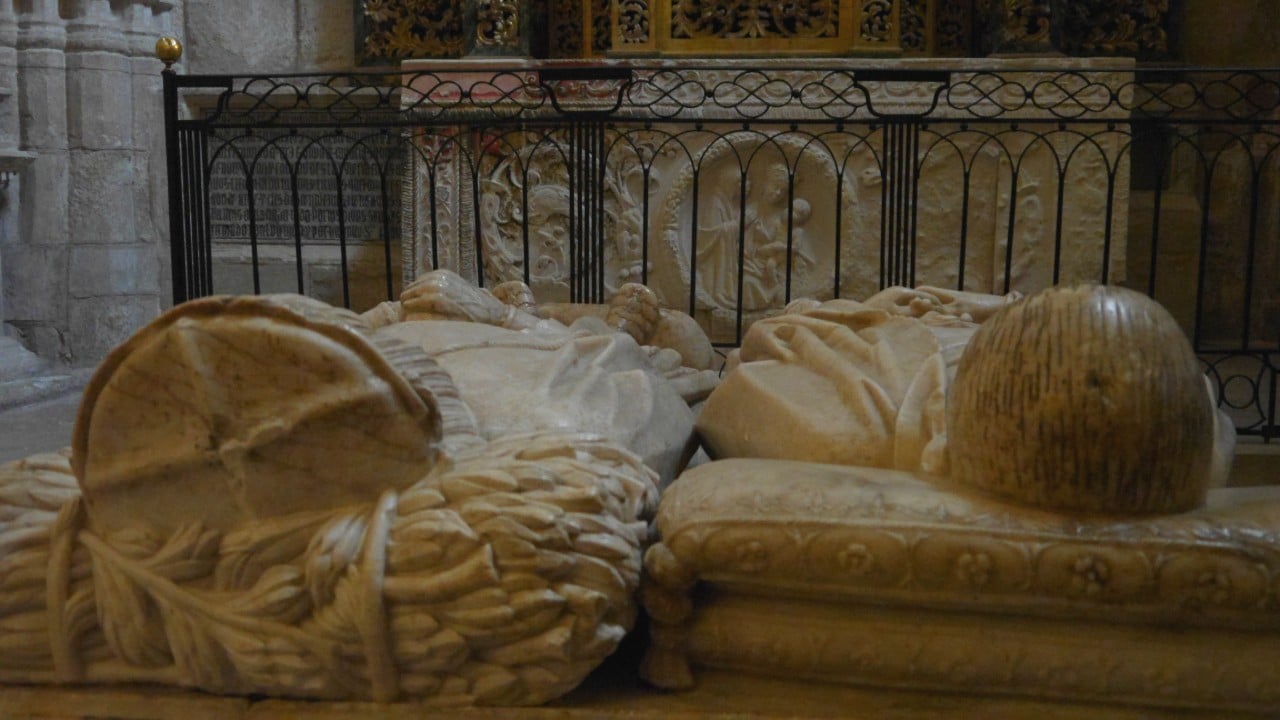
El Doncel, along with the cathedral and the castle, are the symbols of Sigüenza.
3. Casa del Doncel
Sigüenza is known as the “town of El Doncel” for hosting his funerary chapel and the house where Martín Vázquez de Arce grew up, which today is a museum.
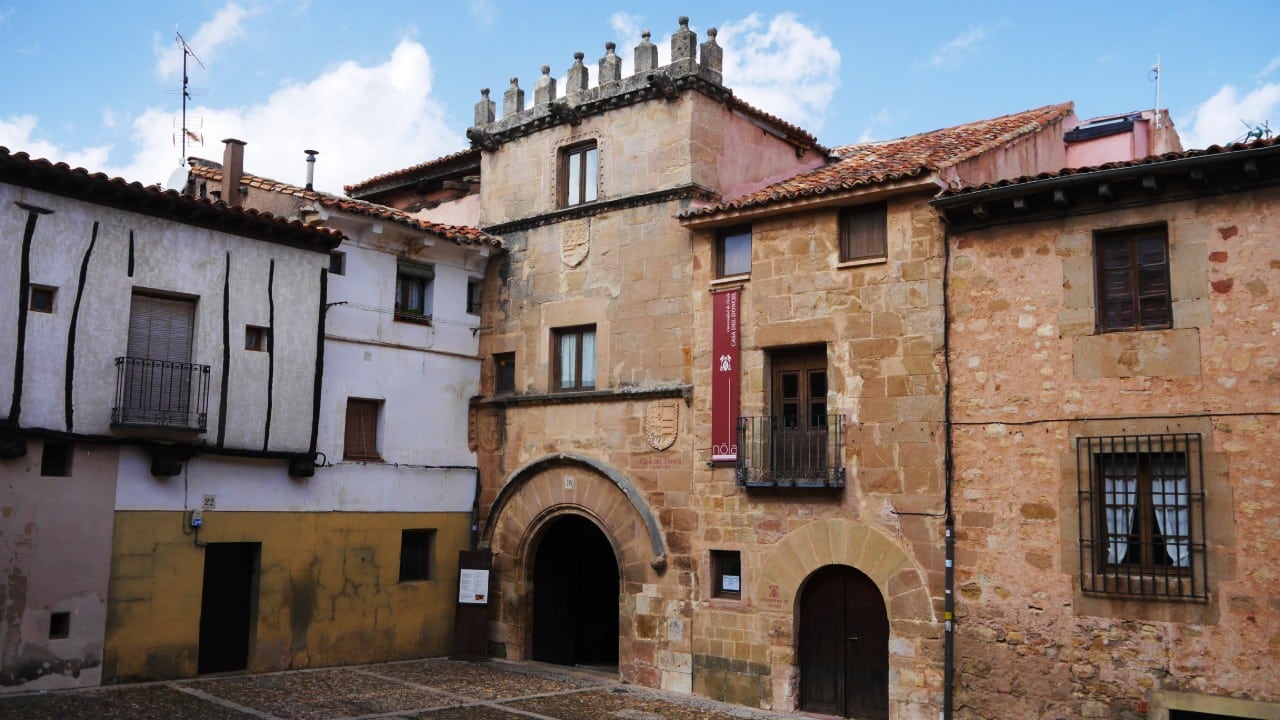
This Gothic-style house began construction in the 13th century and features three floors with various rooms exhibiting Mudejar architectural details. The museum’s highlights include exhibitions dedicated to looms and knotted carpets and a display of guitars and vihuelas used in making Baroque music. They are the precursors of the Spanish guitar.
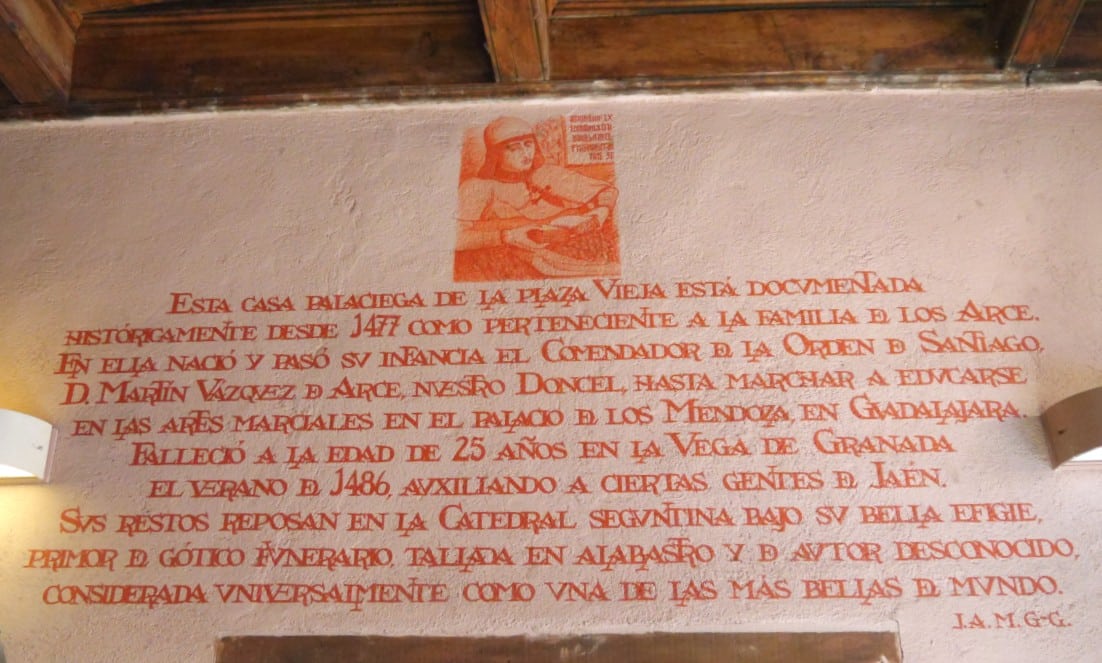
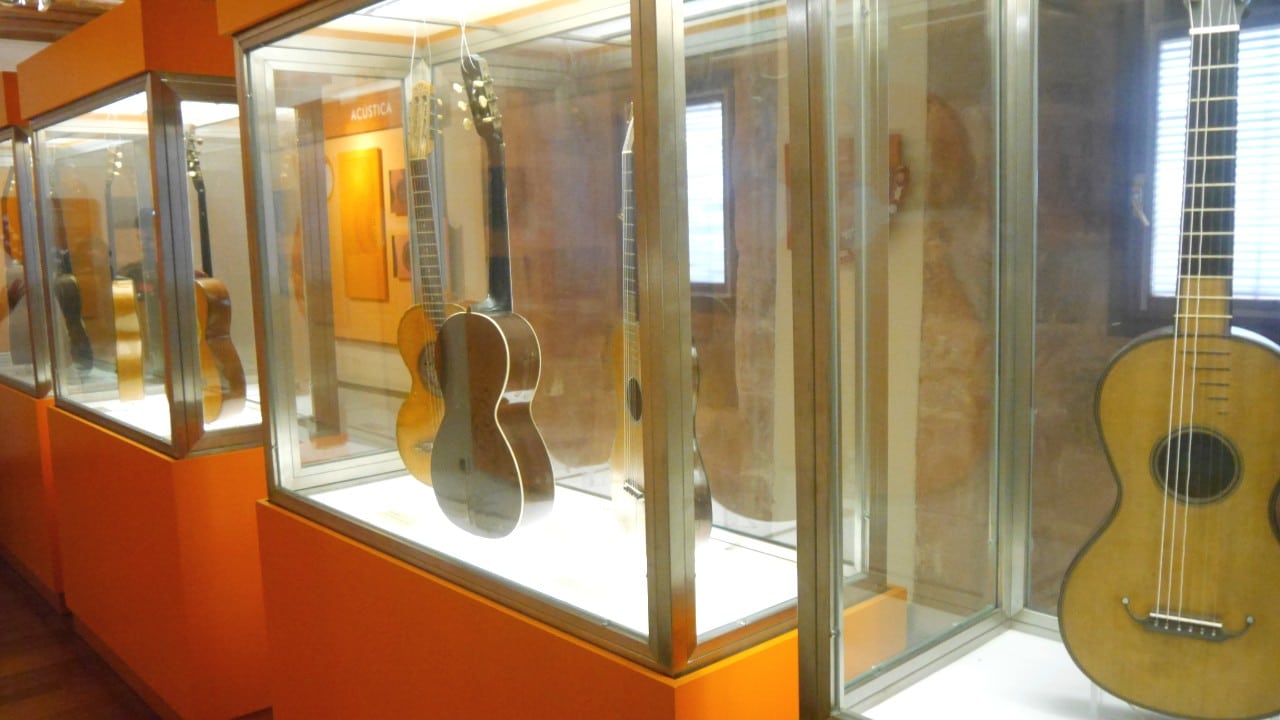
Although most of the Casa del Doncel’s rooms function today as classrooms for summer courses at the University of Alcalá de Henares, a tour of this building gives a better idea of how Castilian noble families lived in the Middle Ages.
4. Plaza Mayor
As is common in Spain, Sigüenza has a main square called Plaza Mayor. The Plaza Mayor of Sigüenza is known for its Renaissance-style arches. Originally, this square was the location for the city’s weekly market and bullfights, among other events.
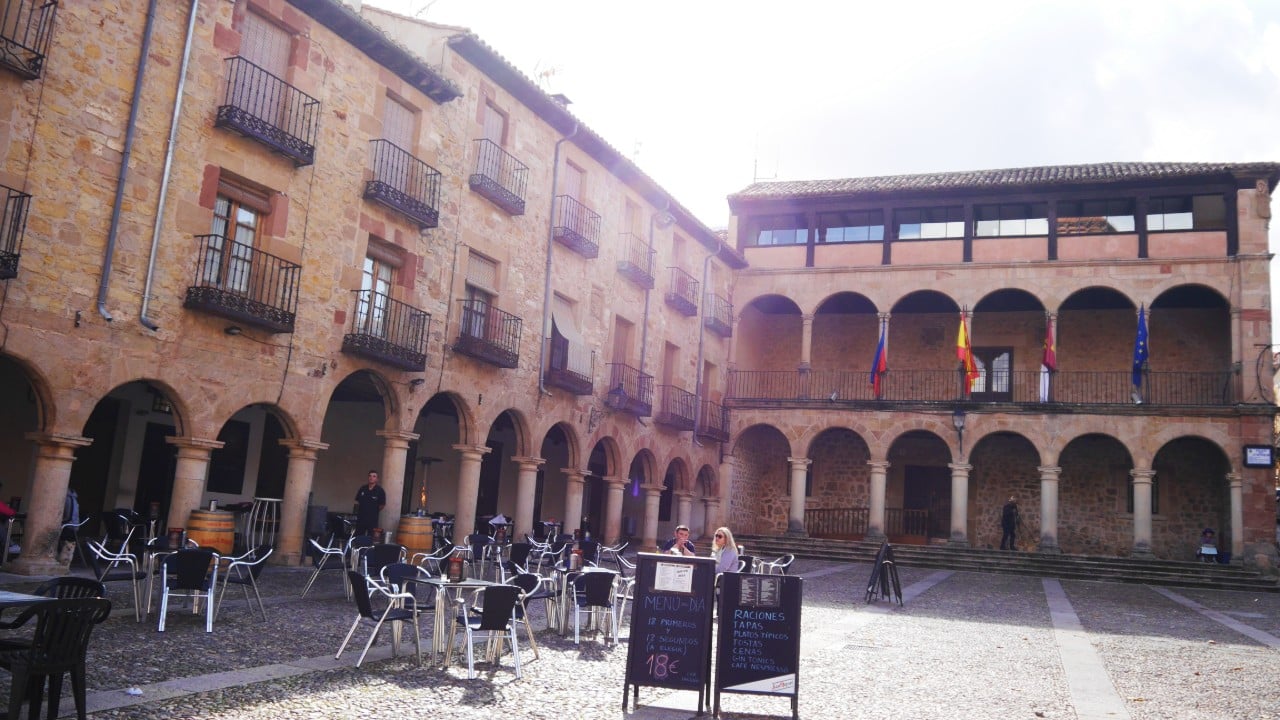
Nowadays, this square is surrounded by restaurants and bars with terraces, making it a great place to hang out, especially during summer afternoons and evenings, when tapas accompanied by cold beer sound especially appetizing.
5. Calle Mayor
As its name suggests, the main street of Sigüenza is next to the Plaza Mayor and is the city’s main street. This steep street connects the cathedral with the castle of Sigüenza, so you will likely have to walk here when visiting the city.
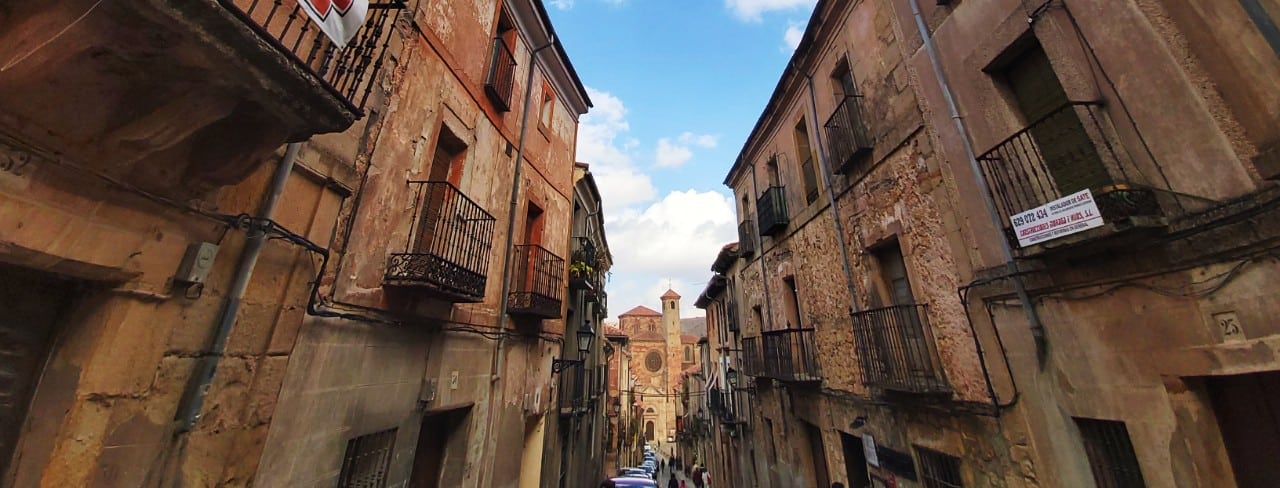
It is a charming street with everything a traveler needs. It is packed with souvenir shops, traditional food stores, restaurants, and cozy guesthouses housed in buildings from different eras.
6. Plazuela de la Cárcel
Before Plaza Mayor was built, the Plazuela de la Cárcel was the main square of Sigüenza.
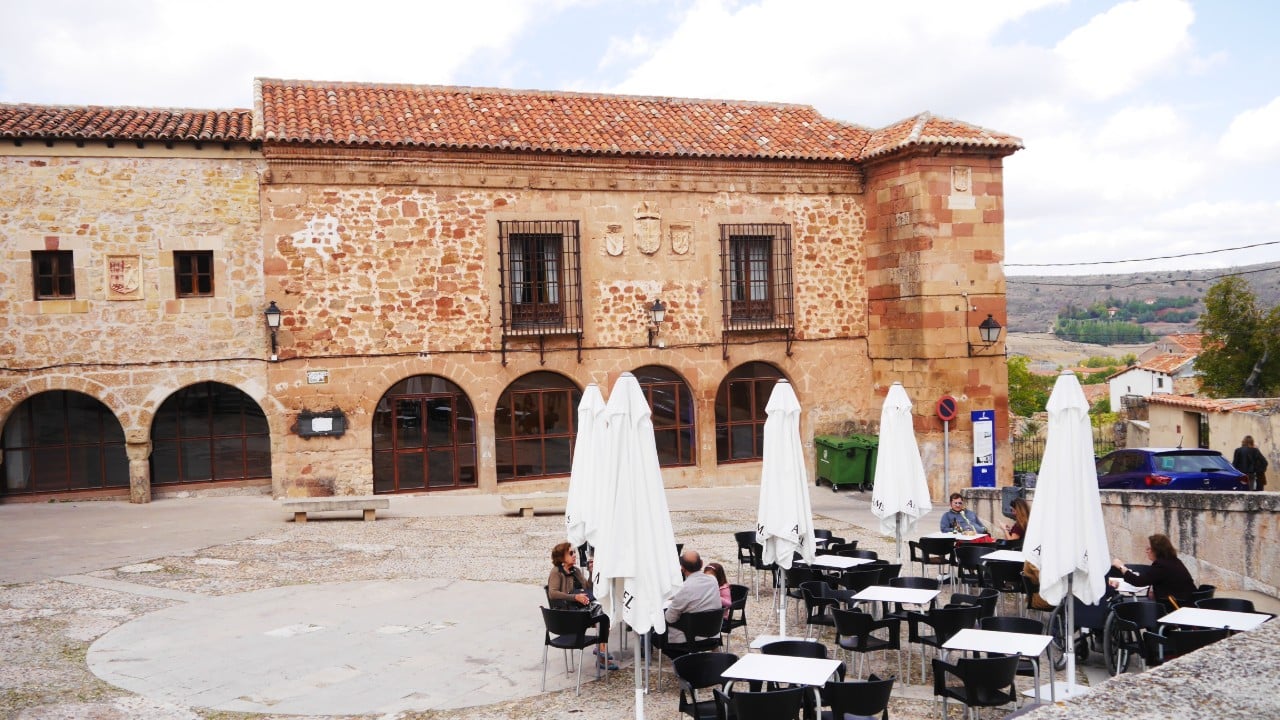
The square gets its name from the medieval city jail in front of it. It’s also home to the Town Hall and the Posada del Sol, which hosts a culture center.
7. Church of Santiago
The church of Santiago, like the cathedral of Sigüenza, is a landmark of Romanesque architecture in Sigüenza, reflecting the city’s prosperity in the medieval period.
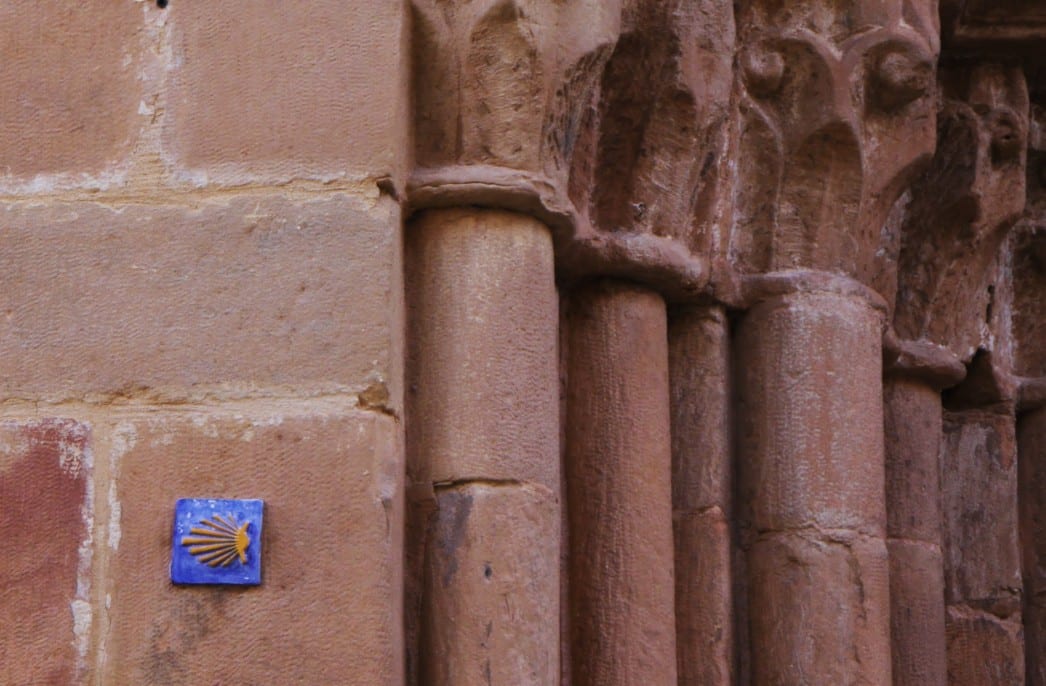
This stone church, built in the 12th century, is located on Calle Mayor and was practically destroyed by the bombing of Francoist forces and their allies during the Civil War. It was later occupied by the Republican army.
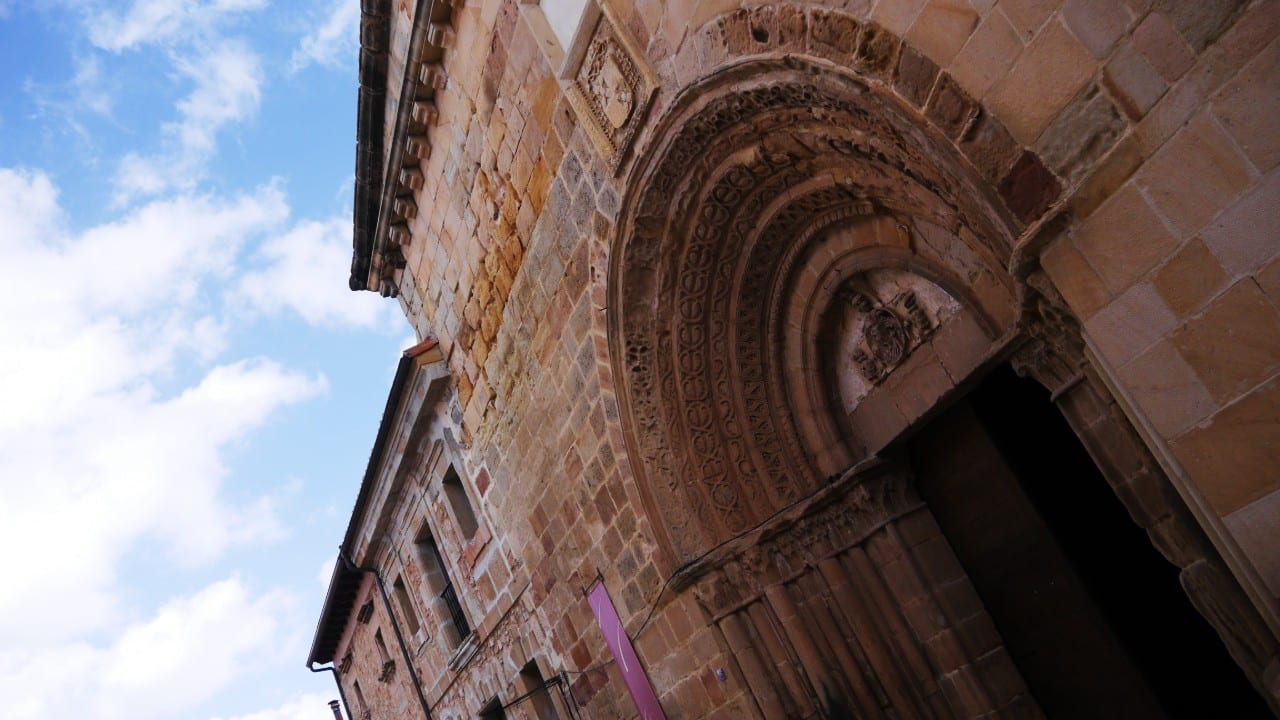
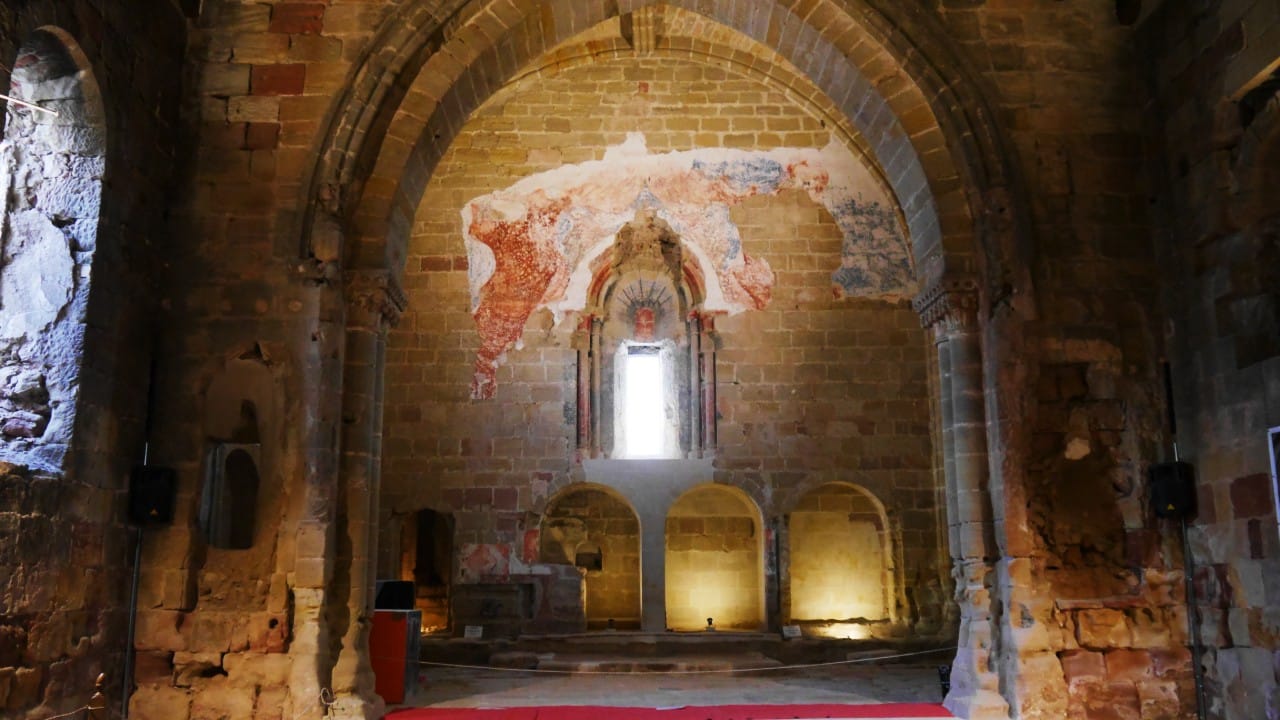
Currently, the church is in the process of restoration and being transformed into the Romanesque Interpretation Center of the province of Guadalajara.
9. Church of San Vicente
Located next to the Casa del Doncel, the church of San Vicente Mártir is another Romanesque gem in Sigüenza.
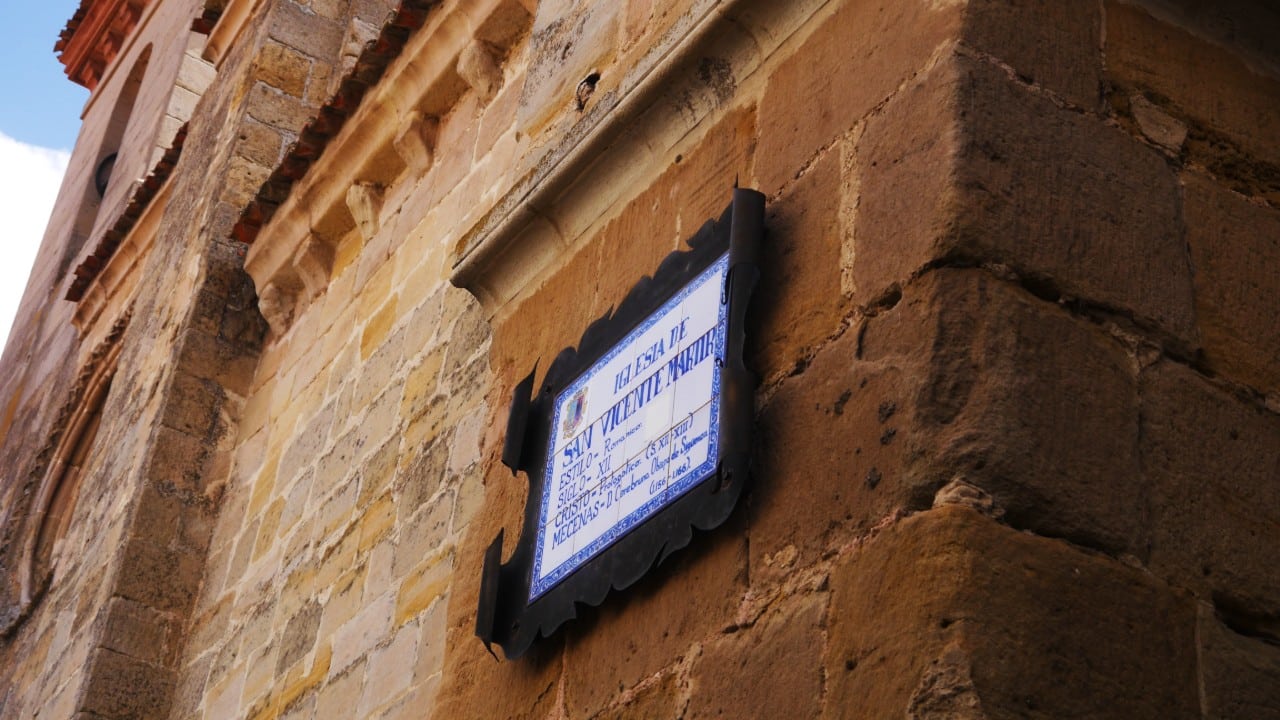
This 12th-century temple has a facade similar to the Church of Santiago, a single central nave, and a wooden roof. It also houses a medieval Christ carving.
9. Walls of Sigüenza
The walls of Sigüenza surround the city’s historic center. Like many of Sigüenza’s other historical attractions, these defensive constructions were erected in the 12th century, expanded in the 14th century, and renovated in the 16th century.
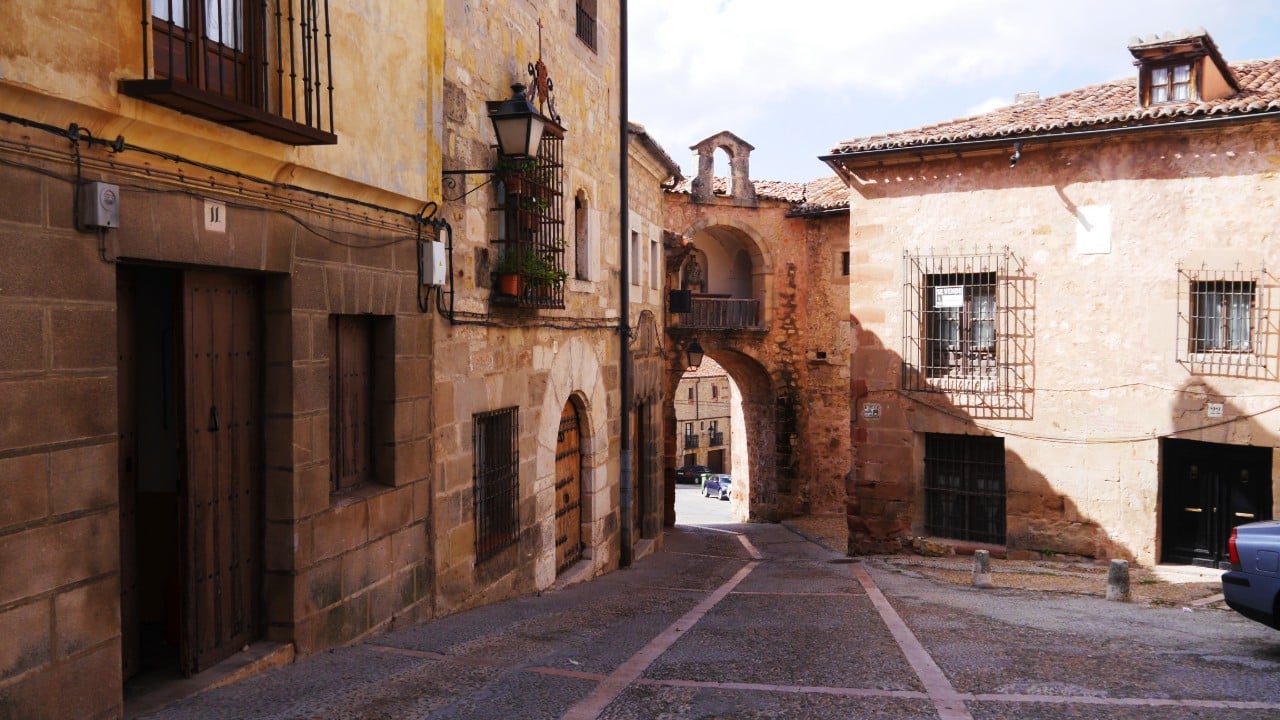
Of the original walls only a few sections survive today, as well as some towers and gates.
The gates that gave access to the city center and are still standing are the Puerta del Hierro (Iron Gate), the Puerta del Sol (Sun Gate), the Toril Gate, and the Arquillo de San Juan or Travesañas Gate. In addition, small passages allow access to some areas outside the walls.
In addition, two towers are preserved, one next to the Iron Gate and one on Valencia Street.
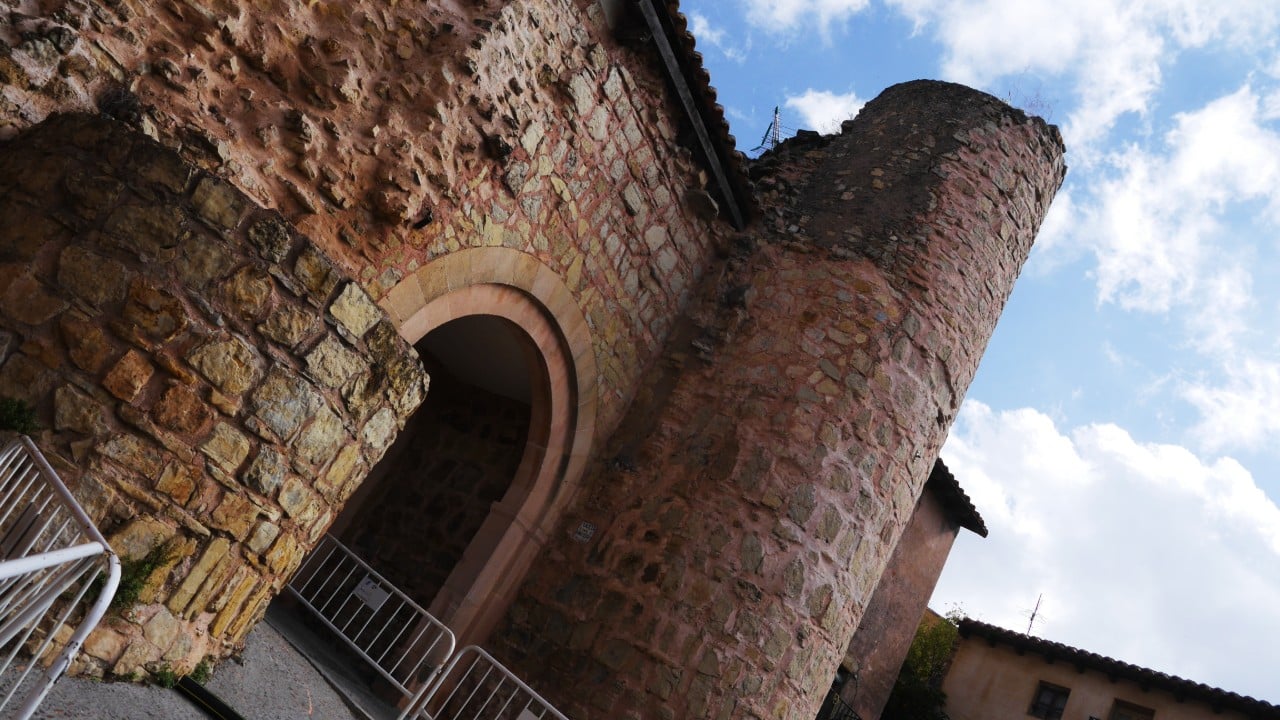

10. Old Jewish Quarter of Sigüenza
There aren’t many remains of the Jewish community in Sigüenza, a city in which Jews lived in harmony with Christians and Moors until the expulsion of the Moors and Jews decreed in 1492 by the Catholic Monarchs.
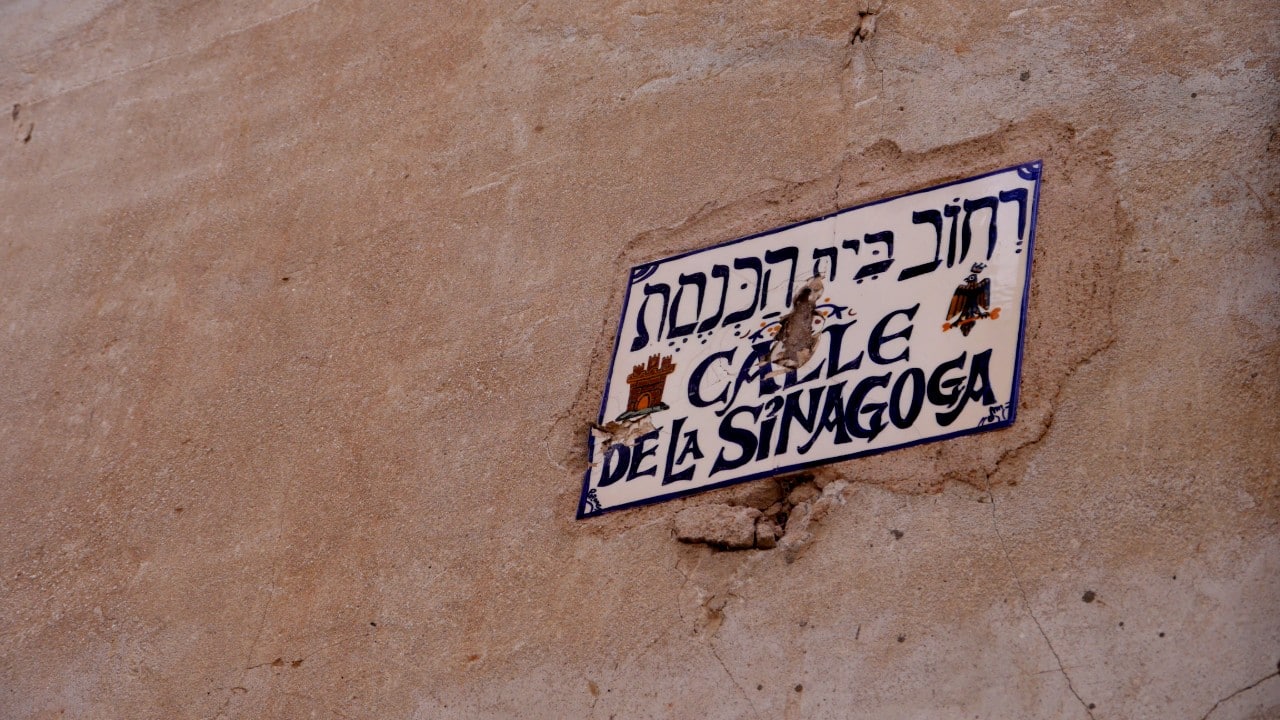
The Jewish Quarter of Sigüenza was centered around a synagogue in the area delimited between the main gate and the Calle Travesaña Baja. The Puerta de Hierro served as an access point between the Jewish quarter and the rest of the city.
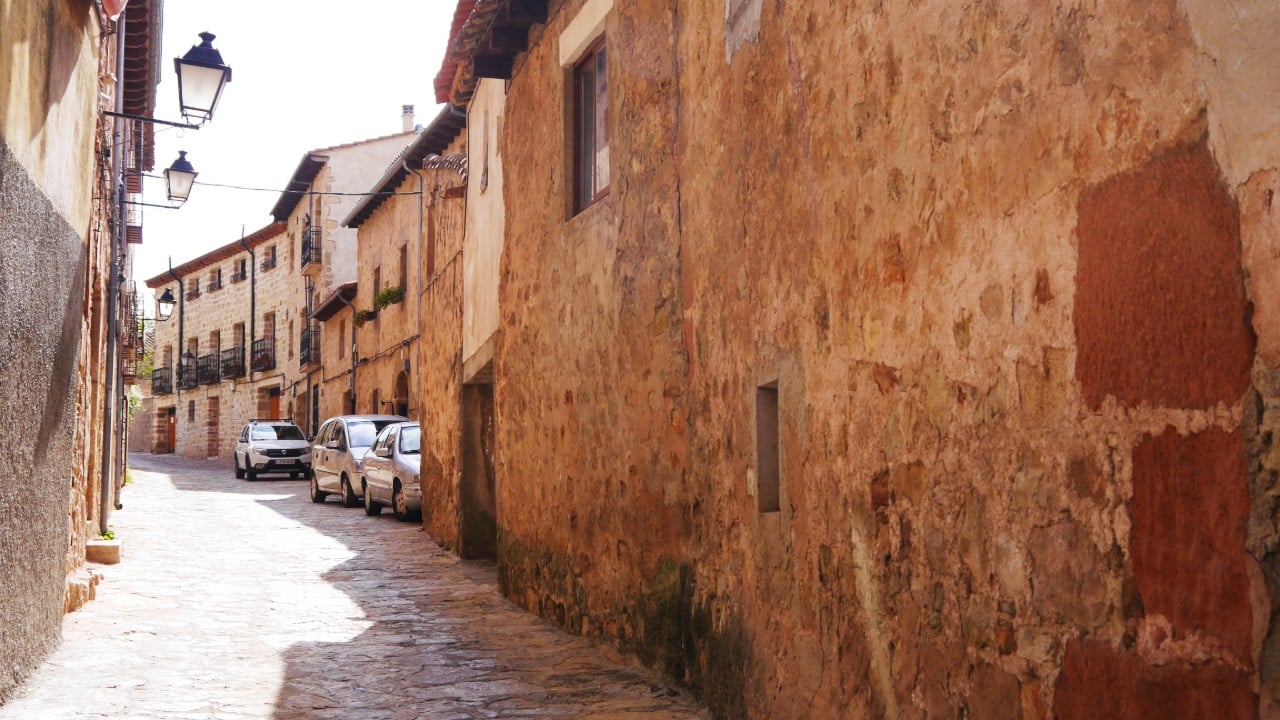
11. Mirador del Polvorín
The Polvorín viewpoint is located a few minutes walk south of the castle of Sigüenza. It is a natural area named after an old cylindrical construction. Originally a windmill, it was later used to store military supplies, hence the name “polvorín,” which means gunpowder deposit.
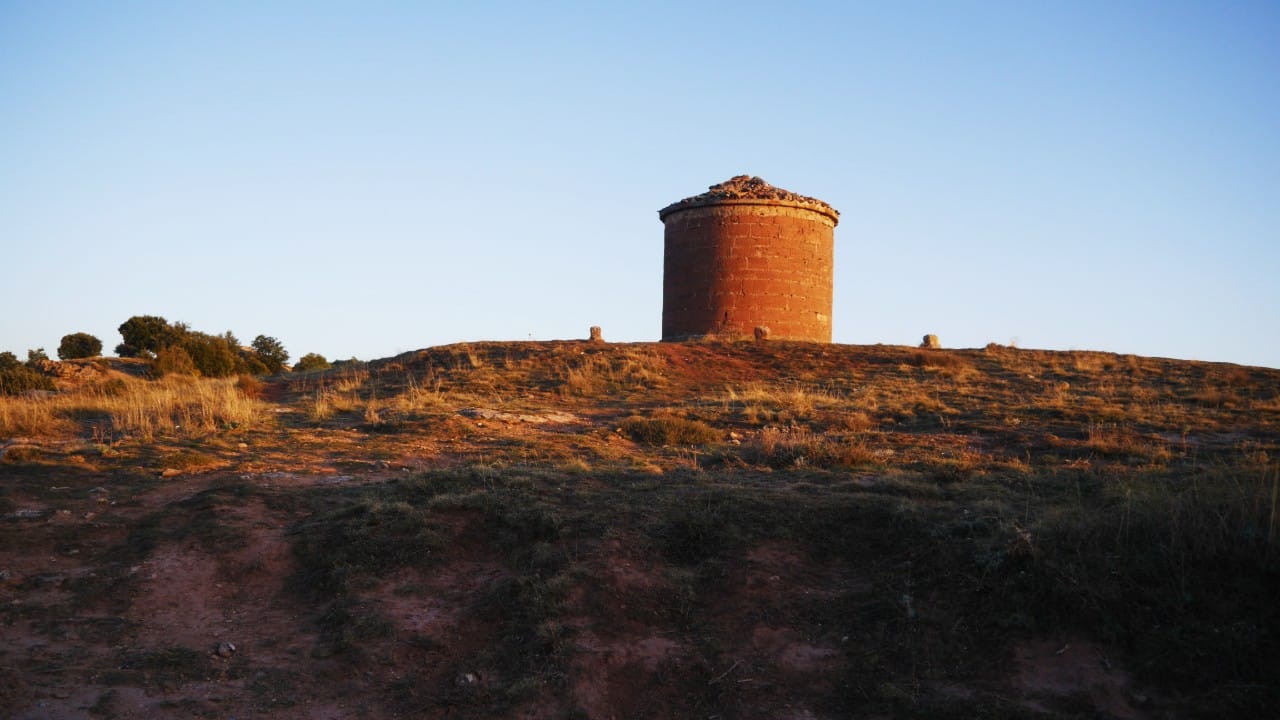
While the windmill is interesting, the real attraction here is the beautiful view from the top of the hill.
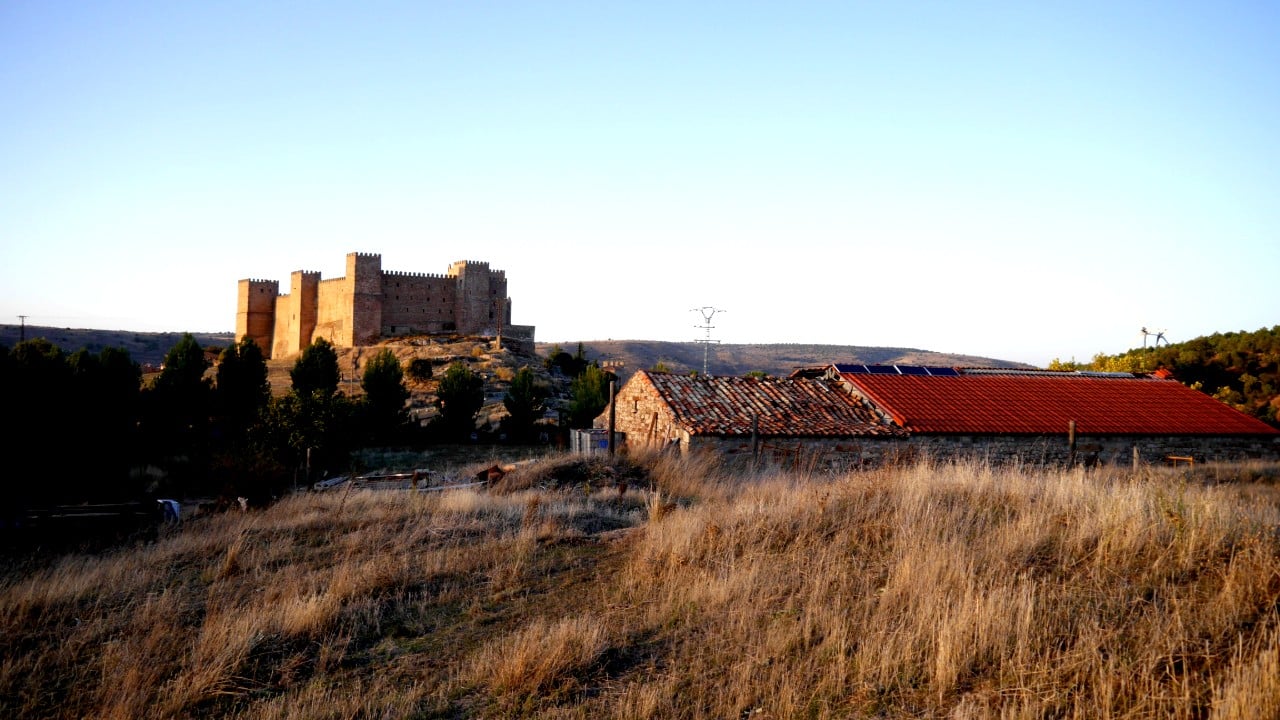
This is also the site of the Mirador Celeste, whose astronomical maps allow visitors to understand the position of the stars after nightfall.
12. Museo Diocesano de Arte Antiguo
The Diocesan Museum of Ancient Art is located in the neoclassical mansion known as “Antigua Casa de los Barrena” in the historic center, opposite the cathedral.
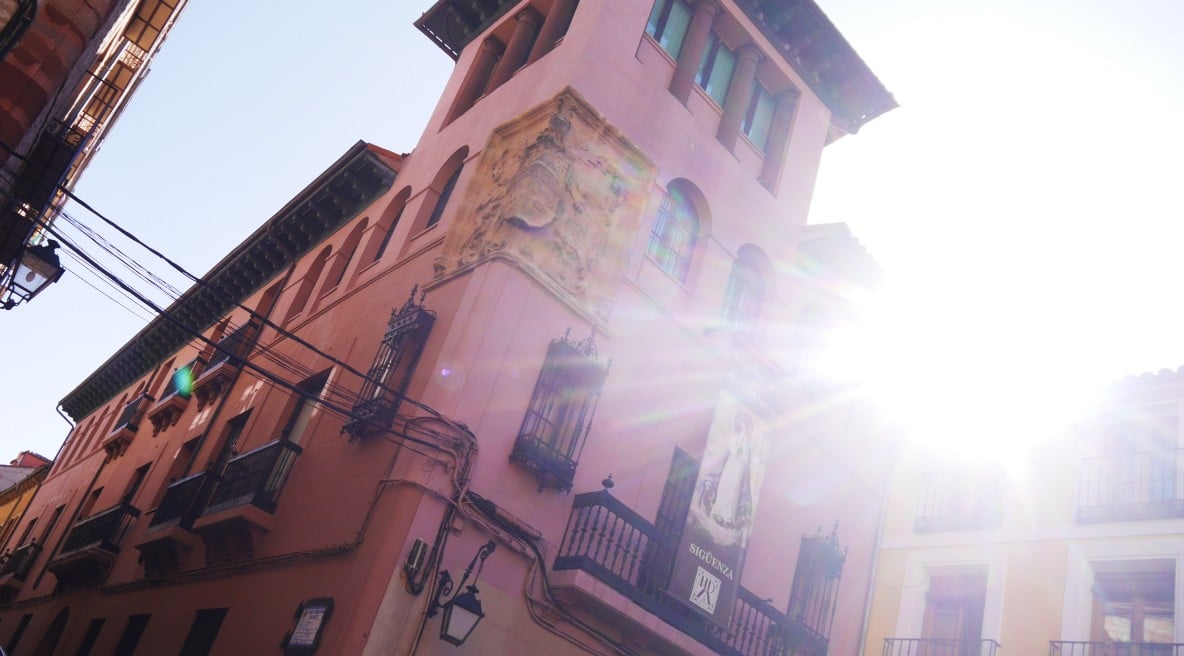
The museum showcases the vast collection of the Diocese of Sigüenza (one of the oldest in Spain), including local archaeological finds and artifacts from pre-Columbian cultures, Mesopotamia, and Classical Greece. The museum also displays medieval Spanish art.
13. Alameda Park
Alameda Park is the main urban park in Sigüenza.
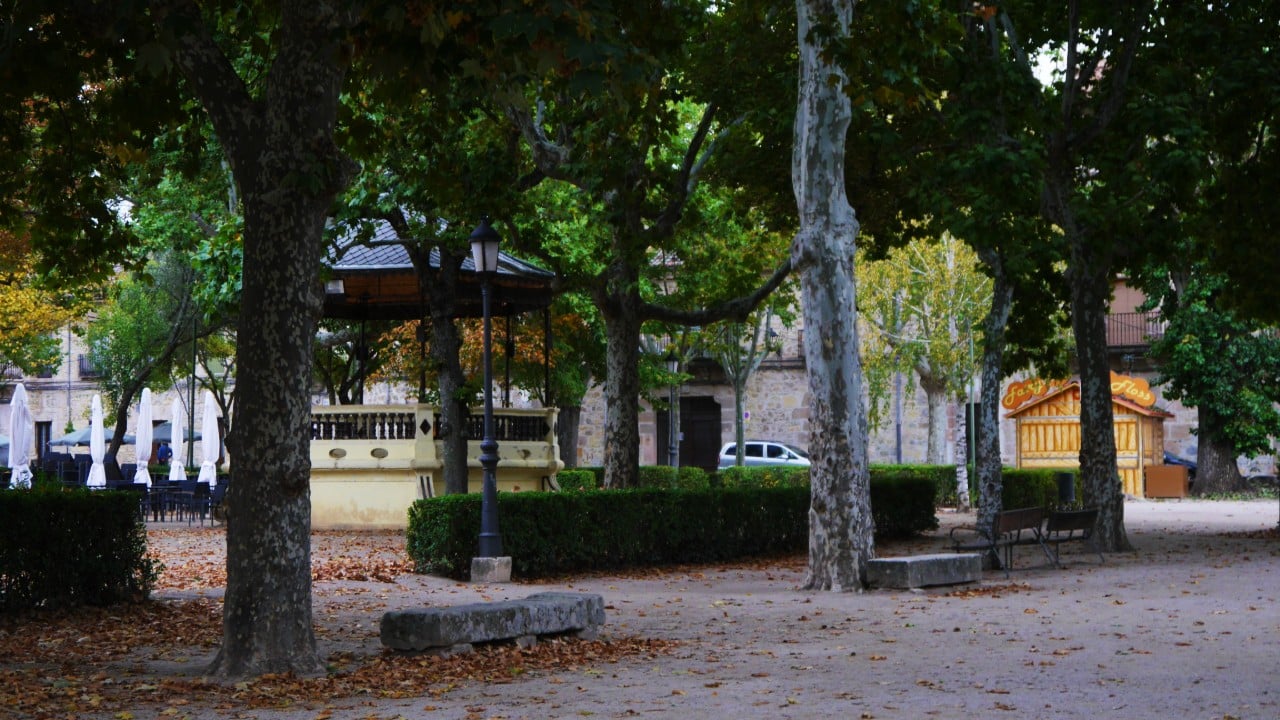
Inaugurated in the early twentieth century and located between the city’s historic center and the railway station, this neoclassical-style park, noted for its gazebo and kiosks, is the main location of city events and festivities.
14. San Francisco Convent
The monastery of Jesus, Mary, and Joseph of Sigüenza, also known as the Ursuline Monastery or Convent of San Francisco, is a baroque-style building located at the beginning of the Paseo de la Alameda, on the way to the cathedral.
Of the original three niches on the main facade, only the figure of the Purísima is preserved. The garden at the entrance is open to the public.
Natural Sights near Sigüenza
Sigüenza is surrounded by natural sites perfect for ecotourism.
Barranco del río Dulce Natural Park
The Barranco del Río Dulce offers a breathtaking walk through the deep gorges carved by the Dulce River. Hikers will enjoy the sight of lush vegetation and hear the trickling streams that crisscross the canyon floor. Keep an eye out for the impressive vulture colony that makes its home atop the sheer cliffs.
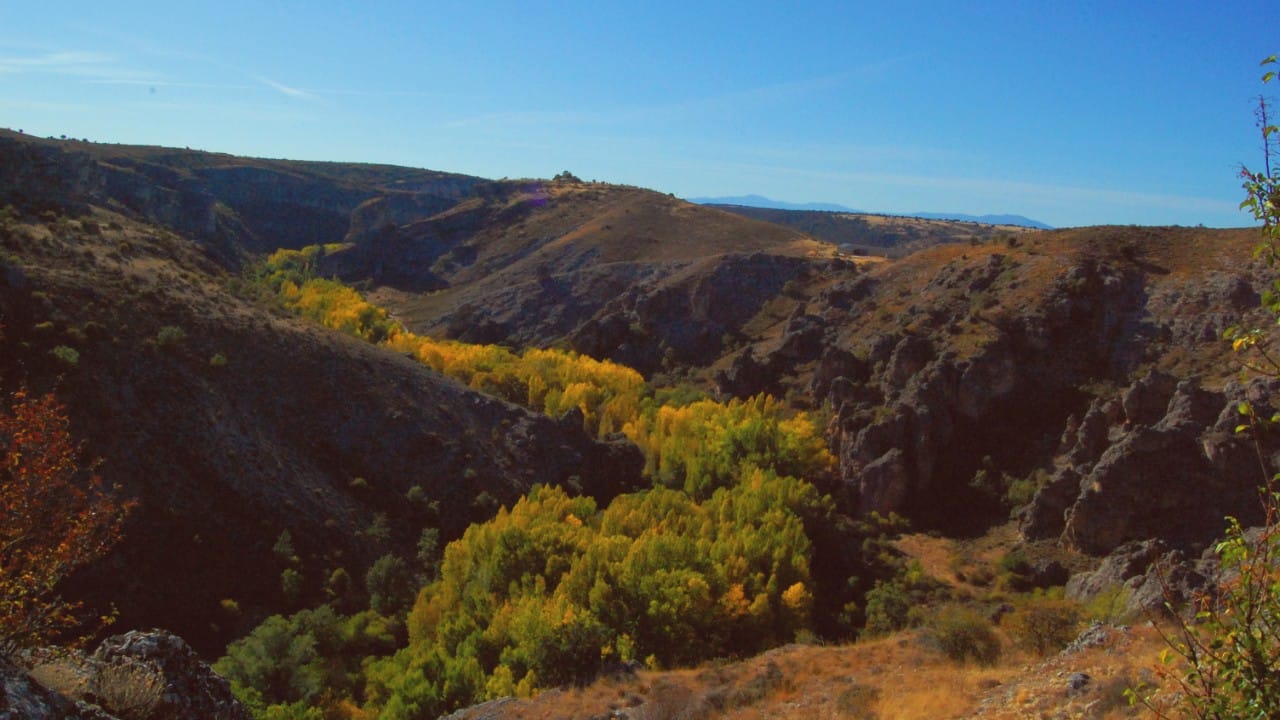
The park became famous thanks to Felix Rodriguez de la Fuente, a beloved naturalist. His nature documentary series aired in the 1970s, showcasing the park’s breathtaking landscape and its role as a home for diverse wildlife, especially birds of prey. People who enjoy outdoor activities like hiking or bird watching have a lot to see here. Well-marked paths guide you through the valleys and around the river. Remember to bring a camera—the views are remarkable, especially at sunset and during the fall.
Useful Information for Your Visit to Sigüenza
Getting to Sigüenza by Train
Sigüenza has good train connections with the cities on the Madrid-Zaragoza corridor, which makes it an excellent choice for a day trip from Madrid.
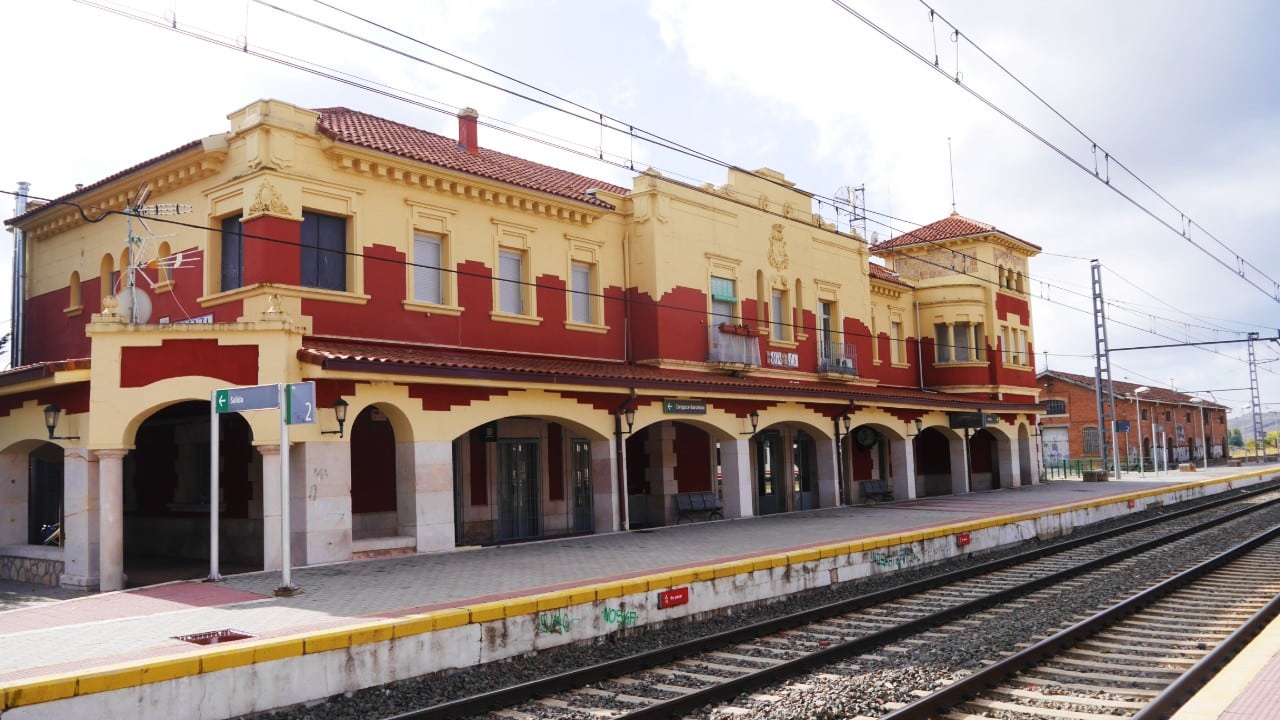
Sigüenza is halfway between Madrid and Zaragoza and can be reached through Regional and Media Distancia trains. Sigüenza-bound trains depart from Madrid-Chamartín station and take approximately two hours.
Between 2 and 7 daily connections, depending on the day of the week. Sigüenza Railway Station is in the north of the city, about fifteen minutes on foot from the historic center of Sigüenza.
Getting to Sigüenza by Bus
There are bus connections with Madrid offered by ALSA. If you arrive in Sigüenza by bus, the bus stop is at Calle Real 16, 19264.
Where to Stay in Sigüenza
My recent trip to Sigüenza was filled with medieval charm through and through. I had the pleasure of staying at the Parador Castillo de Sigüenza, a hotel within an authentic castle. The experience was nothing short of royal, with its amazing architecture and old-timey decor. The meals were also delightful, and the views were amazing.
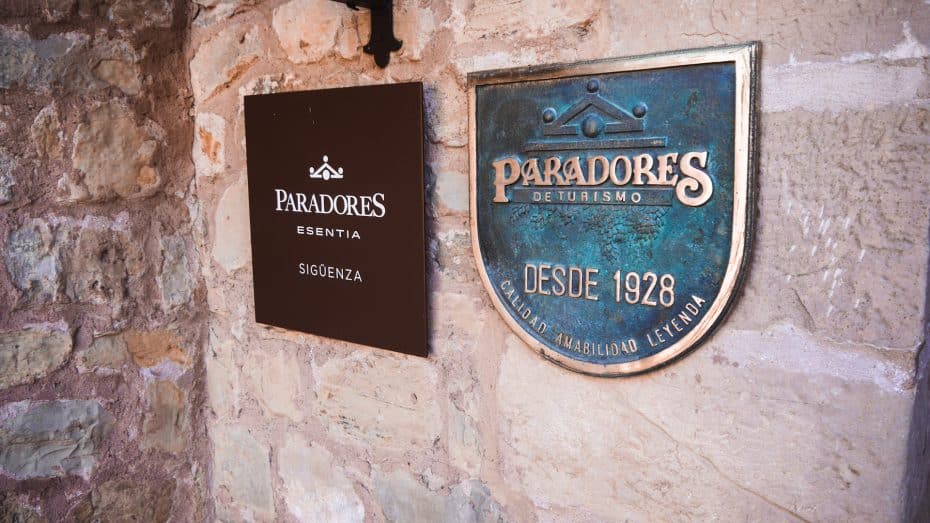
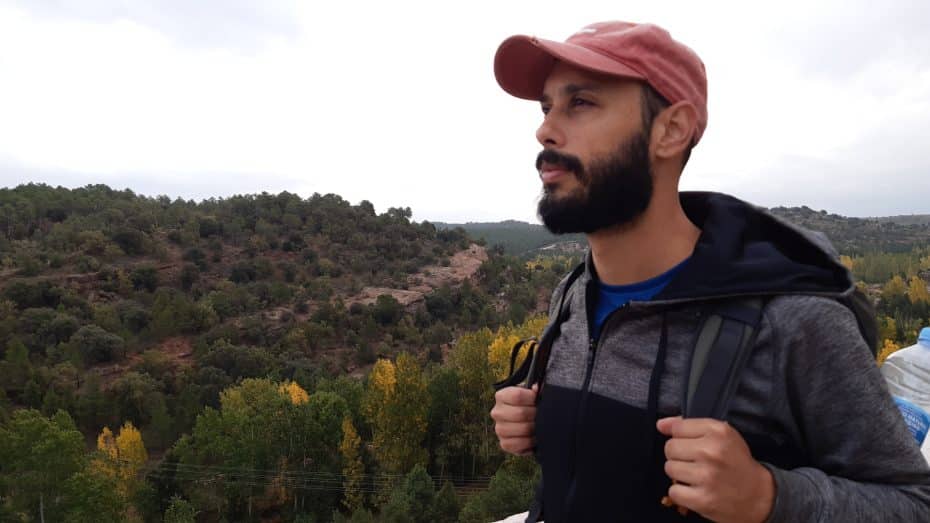
I would strongly recommend staying near the city center when visiting Sigüenza. It’s just convenient being close to the cobbled lanes, exploring quaint shops, and being able to go out for a beer or tapas after sunset.



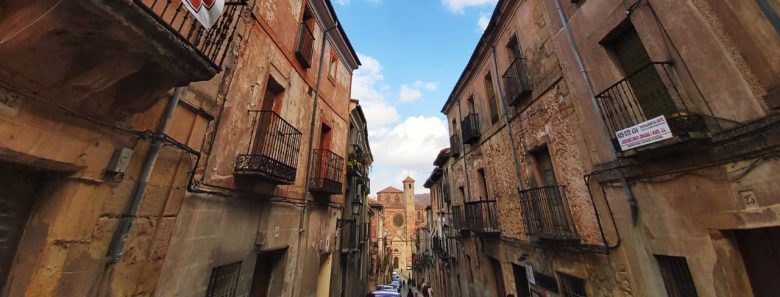
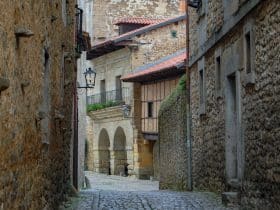
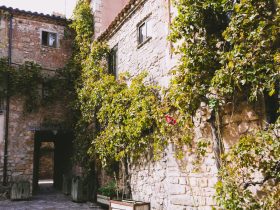
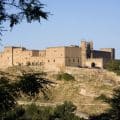
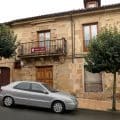
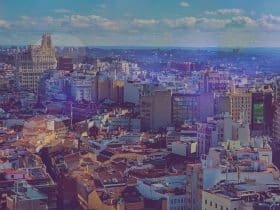
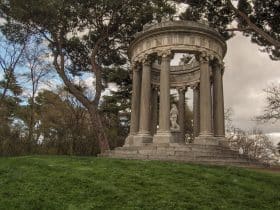




















Leave a Reply
View Comments